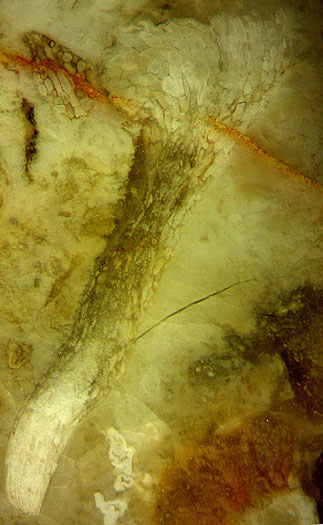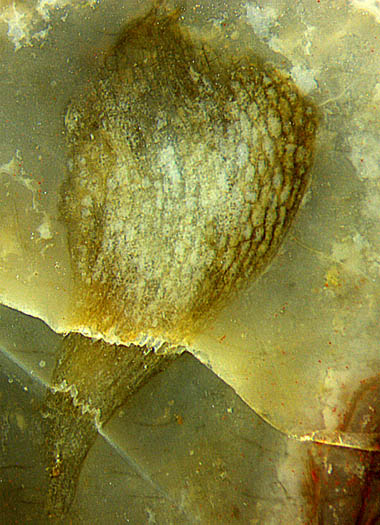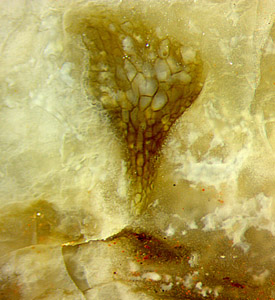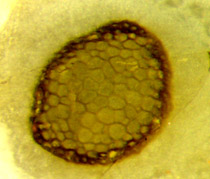Permian tree fern seedlings or enations ?



What looks like a tiny first leaf of the extant male fern Dryopteris but is
found fossilized among remains of the Permian tree fern Scolecopteris may
tentatively be taken for a seedling of the latter, emerging from
a flat object which could be the related gametophyte
(Fig.1). An alternative interpretation suggested by the fact that fern
rhizomes and frond stalks often bear enations
or scales of various size and shape [1] cannot be excluded but seems
less realistic.
Fig.1: Tiny first leaflet of germinating tree fern Scolecopteris
emerging from prostrate gametophyte: tentative interpretation. Height
of the picture 2mm.
Figs.2,3: Similar as Fig.1, same scale, height
of the pictures 3.5mm.
The seedlings were unexpectedly found while looking for
the "maggot
fern" Scolecopteris
on
cut faces of a chert
boulder obtained from Gert
Müller. The partially transparent
chalzedony offers a 3D-aspect in some
places, as in Fig.2. There the
uppermost part of the bulging tissue with clearly marked cell walls is
cut away. Similar shapes as shown here are known from own finds [2,3].
Conspicuous is the deviating shape in Fig.3. It is a rare view because
a long stalk is not often aligned along the cut face but more often
more or less across (Fig.4).

Figs.4a,b: Cross-section of the lower stalk-like part of a
leaflet, (a) scale twice as large as in Figs.1-3
for better visibility, and (b) same scale for better comparison. Width
of the pictures 0.7mm.

Fig.5 (right): Cross-section
of the upper part of a leaflet, same scale as
Figs.1-3,4b, picture size 1.34mm.
This
cross-section of the bulging upper part of a leaflet (Fig.5) has been
taken from another chert sample with Scolecopteris
because no suitable one was found among
the above seedlings (Bu7/86).
These figures show that (1) cell size varies greatly within one leaflet
and (2) the expected leaf-like flattening of the club-shaped "leaflets"
does not yet appear at this early growth stage.
Thanks are due to the fossil collector Gert
Müller
(Dresden + Düren), who found the chert sample of 8.1kg from which
Figs.1-4 have been taken, at the "maggot stone" site (at the
boundary between the
municipalities Kleinnaundorf and Burgk, Freital) in 2003. It offers
more interesting details and is now
stored in
the own collection under the
label
Bu7/140. Fig.5 has been taken from a sample of 5.3kg (Bu7/86) found at
the same location in 2001.
H.-J.
Weiss
2018
[1] K.U. Kramer,
J.J. Schneller, E.
Wollenweber: Farne und Farnverwandte. Stuttgart 1995
[2] H.-J.
Weiss: Keimpflanzen des Baumfarns Scolecopteris /Psaronius
aus dem Rotliegend (Unter-Perm). Veröff. Naturhist. Mus. Schleusingen
16(2001), 15-16.
[3] H.-J.
Weiss: Farnkeime im
Kieseltorf. Fossilien 19(2002), 263.
|
 |
 21 21 |

 21
21






 21
21